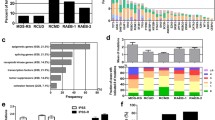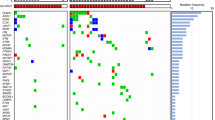Abstract
Genomic characterization of patients with myeloproliferative neoplasms (MPN) may lead to better diagnostic classification, prognostic assessment, and treatment decisions. These goals are particularly important in myelofibrosis (MF). We performed target Next Generation Sequencing for a panel of 255 genes and Chromosome Microarray Analysis (CMA) in 27 patients with MF. Patients were classified according to genomic findings and we compared the performance of a personalized prognostication system with IPSS, MIPSS70 and MIPSS70 + v2. Twenty-six patients presented mutations: 11.1% had single driver mutations in either JAK2, CALR or MPL; 85.2% had mutations in non-restricted genes (median: 2 per patient). CMA was abnormal in 91.7% of the 24 cases with available data. Copy-Number-Neutral Loss-of-Heterozygosity was the most common finding (66.7%). Del13q was the most frequent copy number variation, and we could define a 2.4 Mb minimally affected region encompassing RB1, SUCLA2 and CLLS2 loci. The largest genomic subgroup consisted of patients with mutations in genes involved with chromatin organization and splicing control (40.7%) and the personalized system showed better concordance and accuracy than the other prognostic systems. Comprehensive genomic characterization reveals the striking genetic complexity of MF and, when combined with clinical data, led, in our cohort, to better prognostication performance.




Similar content being viewed by others
References
Tefferi A. Myelofibrosis with myeloid metaplasia. N Engl J Med. 2000;342:1255–65.
Vainchenker W, Kralovics R. Genetic basis and molecular pathophysiology of classical myeloproliferative neoplasms. Blood. 2017;129:667–79.
Tefferi A, Lasho TL, Finke CM, Knudson a R, Ketterling R, Hanson CH, et al. CALR vs JAK2 vs MPL-mutated or triple-negative myelofibrosis: clinical, cytogenetic and molecular comparisons. Leukemia. 2014;28:1472–7.
Rumi E, Pietra D, Pascutto C, Guglielmelli P, Martínez-Trillos A, Casetti I, et al. Clinical effect of driver mutations of JAK2, CALR, or MPL in primary myelofibrosis. Blood. 2014;124:1062–9.
Nangalia J, Green AR. Myeloproliferative neoplasms: from origins to outcomes. Blood. 2017;130:2475–83.
Grinfeld J, Nangalia J, Green AR. Molecular determinants of pathogenesis and clinical phenotype in myeloproliferative neoplasms. Haematologica. 2017;102:7–17.
Pontus L, Axel K. Clonal evolution and clinical correlates of somatic mutations in myeloproliferative neoplasms. Blood. 2014;123:2220–8.
Tefferi A, Mesa RA, Schroeder G, Hanson CA, Li CY, Dewald GW. Cytogenetic findings and their clinical relevance in myelofibrosis with myeloid metaplasia. Br J Haematol. 2001;113:763–71.
De Paula Junior MR, Nonino A, Nascimento JM, Bonadio RS, Pic-Taylor A, De Oliveira SF, et al. High frequency of copy-neutral loss of heterozygosity in patients with myelofibrosis. Cytogenet Genome Res. 2018;154:62–70.
Kralovics R, Guan Y, Prchal JT. Acquired uniparental disomy of chromosome 9p is a frequent stem cell defect in polycythemia vera. Exp Hematol. 2002;30:229–36.
Rumi E, Pietra D, Guglielmelli P, Bordoni R, Casetti I, Milanesi C, et al. Acquired copy-neutral loss of heterozygosity of chromosome 1p as a molecular event associated with marrow fibrosis in MPL-mutated myeloproliferative neoplasms. Blood. 2013;121:4388–95.
Score J, Cross NCP. Acquired uniparental disomy in myeloproliferative neoplasms. Hematol Oncol Clin North Am. 2012;26:981–91.
Mesa RA, Silverstein MN, Jacobsen SJ, Wollan PC, Tefferi A. Population-based incidence and survival figures in essential thrombocythemia and agnogenic myeloid metaplasia: an Olmsted county study, 1976–1995. Am J Hematol. 1999;61:10–5.
Tefferi A, Lasho TL, Jimma T, Finke CM, Gangat N, Vaidya R, et al. One thousand patients with primary myelofibrosis: the mayo clinic experience. Mayo Clin Proc. 2012;87:25–33.
Cervantes F, Dupriez B, Pereira A, Passamonti F, Reilly JT, Morra E, et al. New prognostic scoring system for primary myelofibrosis based on a study of the International working group for myelofibrosis research and treatment. Blood. 2009;113:2895–901.
Passamonti F, Cervantes F, Vannucchi AM, Morra E, Rumi E, Pereira A, et al. A dynamic prognostic model to predict survival in primary myelofibrosis: a study by the IWG-MRT (international working group for myeloproliferative neoplasms research and treatment). Blood. 2010;115:1703–8.
Bose P, Verstovsek S. The evolution and clinical relevance of prognostic classification systems in myelofibrosis. Cancer. 2016;122:681–92.
Guglielmelli P, Lasho TL, Rotunno G, Mudireddy M, Mannarelli C, Nicolosi M, et al. MIPSS70: mutation-enhanced international prognostic score system for transplantation-age patients with primary myelofibrosis. J Clin Oncol. 2018;36:310–8.
Tefferi A, Guglielmelli P, Lasho TL, Gangat N, Ketterling RP, Pardanani AD, et al. MIPSS70+version 2.0: mutation and karyotype-enhanced international prognostic scoring system for primary myelofibrosis. J Clin Oncol. 2018;36:1769–70.
Grinfeld J, Nangalia J, Baxter EJ, Wedge DC, Angelopoulos N, Cantrill R, et al. Classification and personalized prognosis in myeloproliferative neoplasms. N Engl J Med. 2018;379:1416–30.
Vardiman JW, Thiele J, Arbera D, Brunning RD, Borowitz MJ, Porwit A, et al. The 2008 revision of the world health organization (WHO) classification of myeloid neoplasms and acute leukemia: rationale and important changes. Blood. 2009;114:937–51.
Arber DA, Orazi A, Hasserjian R, Borowitz MJ, Le BMM, Bloomfield CD, et al. The 2016 revision to the world health organization classification of myeloid neoplasms and acute leukemia. Blood. 2016;127:2391–406.
Barosi G, Mesa RA, Thiele J, Cervantes F, Campbell PJ, Verstovsek S, et al. Proposed criteria for the diagnosis of post-polycythemia vera and post-essential thrombocythemia myelofibrosis: a consensus statement from the international working group for myelofibrosis research and treatment [6]. Leukemia. 2008;22:437–8.
Santos FPS, Getta B, Masarova L, Famulare C, Schulman J, Datoguia TS, et al. Prognostic impact of RAS-pathway mutations in patients with myelofibrosis. Leukemia. 2020;34:799–810.
Grinfeld J, Nangalia J, Baxter EJ, Wedge DC, Angelopoulos N, Cantrill R, et al. Supplement to: classification and personalized prognosis in myeloproliferative neoplasms. N Engl J Med. 2018;379:1416–30.
Sallman DA, Padron E. Integrating mutation variant allele frequency into clinical practice in myeloid malignancies. Hematol Oncol Stem Cell Ther. 2016;9:89–95.
Rice KL, Lin X, Wolniak K, Ebert BL, Berkofsky-Fessler W, Buzzai M, et al. Analysis of genomic aberrations and gene expression profiling identifies novel lesions and pathways in myeloproliferative neoplasms. Blood Cancer J. 2011;1:e40.
Stegelmann F, Bullinger L, Griesshammer M, Holzmann K, Habdank M, Kuhn S, et al. High-resolution single-nucleotide polymorphism array-profiling in myeloproliferative neoplasms identifies novel genomic aberrations. Haematologica. 2010;95:666–9.
Grand FH, Hidalgo-curtis CE, Ernst T, Zoi K, Zoi C, Kreil S, et al. Frequent CBL mutations associated with 11q acquired uniparental disomy in myeloproliferative neoplasms. Blood. 2009;113:6182–92.
Yoshida K, Sanada M, Shiraishi Y, Nowak D, Nagata Y, Yamamoto R, et al. Frequent pathway mutations of splicing machinery in myelodysplasia. Nature. 2011;478:64–9.
La Starza R, Wlodarska I, Aventin A, Falzetti D, Crescenzi B, Martelli MF, et al. Molecular delineation of 13q deletion boundaries in 20 patients with myeloid malignancies. Blood. 1998;91:231–7.
Tanaka K, Arif M, Eguchi M, Guo SX, Hayashi Y, Asaoku H, et al. Frequent allelic loss of the RB, D13S319 and D13S25 locus in myeloid malignancies with deletion/translocation at 13q14 of chromosome 13, but not in lymphoid malignancies. Leukemia. 1999;13:1367–73.
Stilgenbauer S, Leupolt E, Ohl S, Wei G, Schröder M, Fischer K, et al. Heterogeneity of deletions involving RB-1 and the D13S25 locus in B-cell chronic lymphocytic leukemia revealed by fluorescence in situ hybridization. Cancer Res. 1995;55:3475–7.
Juneau AL, Kaehler M, Christensen ER, Schad CR, Zinsmeister AR, Lust J, et al. Detection of RB1 deletions by fluorescence in situ hybridization in malignant hematologic disorders. Cancer Genet Cytogenet. 1998;103:117–23.
Dyson NJ. RB1: A prototype tumor suppressor and an enigma. Genes Dev. 2016;30:1492–502.
Ishak CA, Dick FA. Conditional haploinsufficiency of the retinoblastoma tumor suppressor gene. Mol Cell Oncol. 2015;2:3–5.
Olcaydu D, Berg T, Gisslinger B, Gisslinger H, Kralovics R. Deletions of chromosome 13q in myeloproliferative neoplasms: mapping, relation to the jak2-v617f mutation and evaluation of potential tumor suppressor candidates. Blood. 2008;112:3724–3724.
Sinclair EJ, Forrest EC, Reilly JT, Watmore AE, Potter AM. Fluorescence in situ hybridization analysis of 25 cases of idiopathic myelofibrosis and two cases of secondary myelofibrosis: monoallelic loss of RB1, D13S319 and D13S25 loci associated with cytogenetic deletion and translocation involving 13q14. Br J Haematol. 2001;113:365–8.
Mehrotra M, Patel KP, Chen T, Miranda RN, Wang Y, Zuo Z, et al. Genomic and clinicopathologic features of primary myelofibrosis with isolated 13q deletion. Clin Lymphoma, Myeloma Leuk. 2015;15:496–505.
Dameshek W. Some speculations on the myeloproliferative syndromes. Blood. 1951;6:372–5.
Buhr T, Hebeda K, Kaloutsi V, Porwit A, Van der Walt J, Kreipe H. European bone marrow working group trial on reproducibility of world health organization criteria to discriminate essential thrombocythemia from prefibrotic primary myelofibrosis. Haematologica. 2012;97:360–5.
Rondelli D, Goldberg JD, Isola L, Price LS, Shore TB, Boyer M, et al. MPD-RC 101 prospective study of reduced-intensity allogeneic hematopoietic stem cell transplantation in patients with myelofibrosis. Blood. 2014;124:1183–91.
Cervantes F, How I. Treat myelofibrosis. Blood. 2014;124:2635–43.
Tefferi A, Guglielmelli P, Pardanani A, Vannucchi AM. Myelofibrosis treatment algorithm 2018. Blood Cancer J. 2018;8:72.
Passamonti F, Maffioli M, Cervantes F, Vannucchi AM, Morra E, Barbui T, et al. Impact of ruxolitinib on the natural history of primary myelofibrosis : a comparison of the DIPSS and the COMFORT-2 cohorts. Blood. 2014;123:1833–5.
Author information
Authors and Affiliations
Corresponding author
Ethics declarations
Conflicts of interest
The authors declare that they have no conflict of interest.
Additional information
Publisher's Note
Springer Nature remains neutral with regard to jurisdictional claims in published maps and institutional affiliations.
Electronic supplementary material
Below is the link to the electronic supplementary material.
About this article
Cite this article
Nonino, A., Campregher, P.V., de Souza Santos, F.P. et al. Genomic characterization and prognostication applied to a Brazilian cohort of patients with myelofibrosis. Int J Hematol 112, 361–368 (2020). https://doi.org/10.1007/s12185-020-02906-w
Received:
Revised:
Accepted:
Published:
Issue Date:
DOI: https://doi.org/10.1007/s12185-020-02906-w




